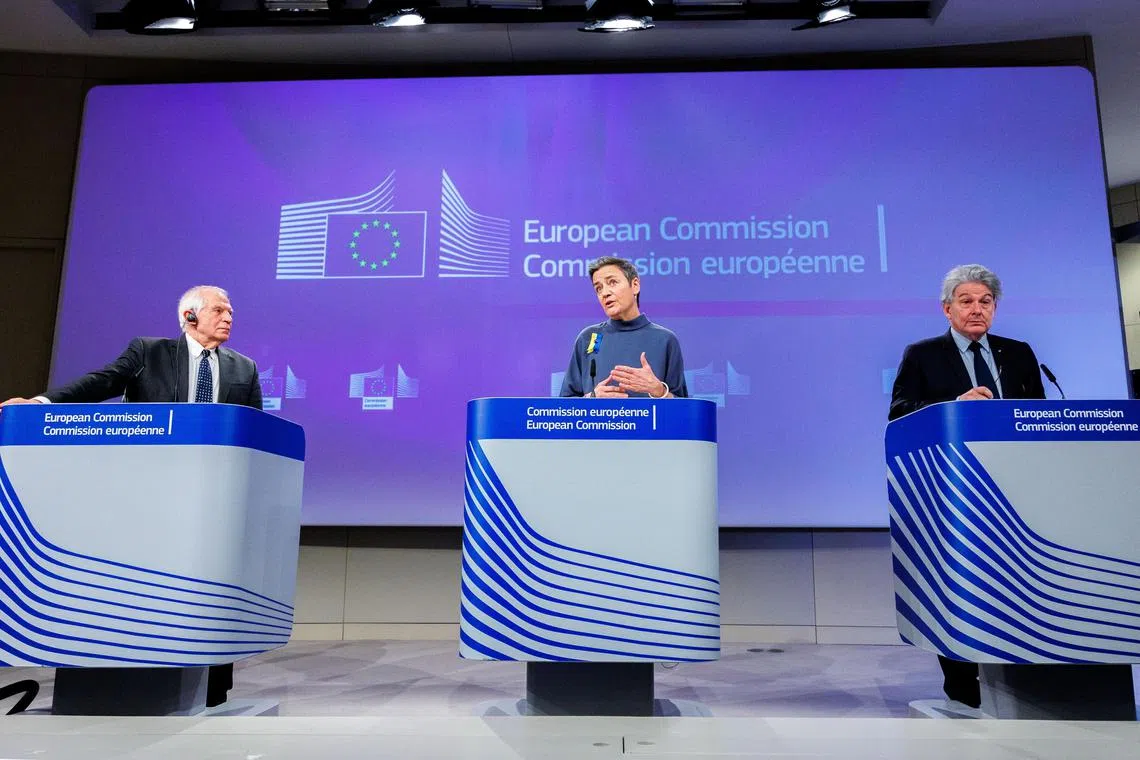EU officials unveil $2b plan to boost arms industry
Sign up now: Get ST's newsletters delivered to your inbox

European Commission vice-president Margrethe Vestager, flanked by European Union policy chief Josep Borrell (left) and EU industry commissioner Thierry Breton, at a press conference on March 5.
PHOTO: EPA-EFE
Follow topic:
BRUSSELS – Top European Union officials on March 5 unveiled plans to boost the continent’s arms industry, arguing that Russia’s war in Ukraine
The European Commission, the EU’s executive body, proposed spending €1.5 billion (S$2.2 billion) to give countries incentives to buy jointly from European firms and encourage industry to raise capacity and develop new technologies.
“In the past two years, we’ve faced a situation of a defence industry without sufficient production capacity to meet the sharp increase of demand,” Ms Margrethe Vestager, a vice-president of the commission, told reporters in Brussels.
“We’ve been vividly confronted with the well-known structural fragmentation along national borders,” said Ms Vestager.
She said EU national governments placing orders with favoured companies from their own countries limited economies of scale, created mistrust and prevented competition.
Ms Vestager acknowledged that €1.5 billion was “not a lot of money when it comes to the defence industry” but said it could still create incentives to get the EU’s 27 national governments – which have responsibility for defence – to work together.
The commission said it wanted to bind Ukraine as closely as possible into its new plans, even though it is not an EU member.
Officials also raised the prospect that the EU could use profits from frozen Russian assets to help Ukraine’s defence industry or even buy arms for Kyiv. But EU members have yet to agree on how those funds should be used.
Alarmed by Russia’s war in Ukraine and bellicose rhetoric from Moscow towards the West, EU countries have sharply increased defence spending in recent years. Much of that money has gone to companies outside Europe.
Between the start of the war and June 2023, EU states spent more than €100 billion on military equipment – 80 per cent of it outside the EU, with more than 60 per cent going to the United States alone, according to the commission.
Buying European
The commission said on March 5 that the EU should aim to procure at least 40 per cent of defence equipment “in a collaborative manner” by 2030 and spend at least 50 per cent of defence procurement budgets within the EU by the same date.
It also proposed a pilot programme to create a European version of the US Foreign Military Sales scheme, under which the United States helps other governments buy from US arms companies.
“We don’t have a Pentagon anywhere. We don’t have an institution that has a strong buying capacity, driving the market and driving industry,” said EU foreign policy chief Josep Borrell. “But we have to cooperate and coordinate.”
To become reality, the proposals will need approval from the EU’s member countries – which have been reluctant to cede power on defence and military policy – and the European Parliament.
Europe’s defence industry association, ASD, gave the proposals a broad initial welcome.
“Speed and financial resources will be crucial for their implementation,” said Mr Jan Pie, the body’s secretary-general.
The proposals will be studied closely by Nato, which has welcomed greater EU efforts on defence but warned they must not duplicate or clash with the transatlantic alliance’s work.
If approved, the €1.5 billion package would be spent between 2025 and 2027.
Mr Thierry Breton, the EU’s industry commissioner, has argued for an EU defence fund of €100 billion.
But that idea has yet to find broad support among EU member countries. REUTERS

